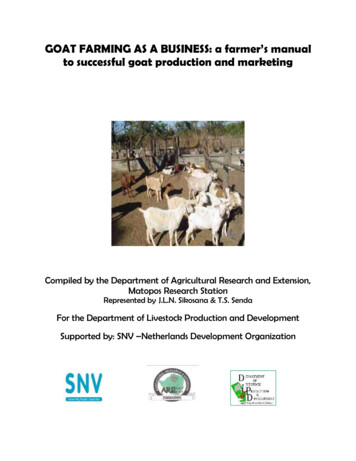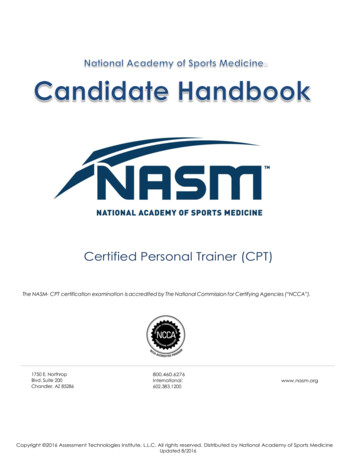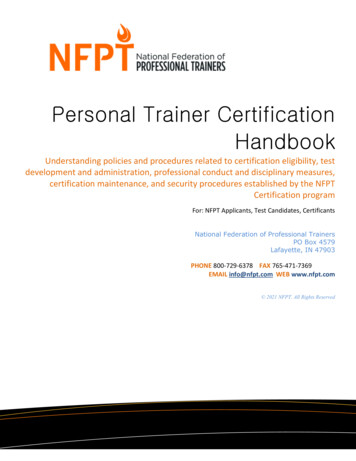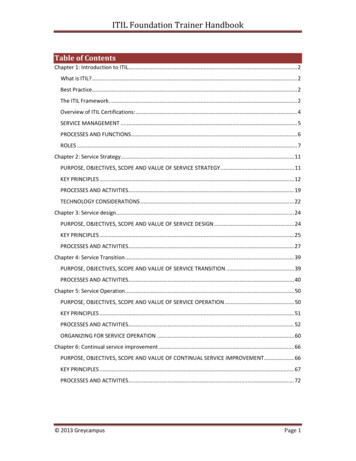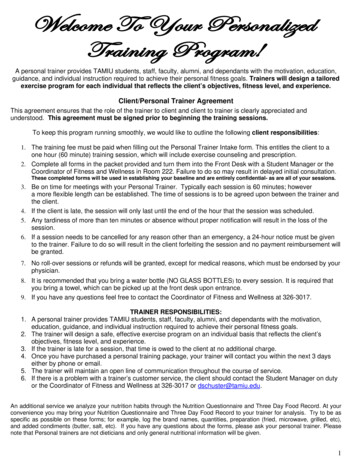
Transcription
Smallholder HorticulturalProduction and BusinessTrainer’s Manual
AcknowledgementsSNV is grateful for the financial support of DANIDA under the RuralAgricultural Revitalization Programme - Commercialization of SmallholderFarmers (RARP-CSF). Furthermore, we would like to acknowledge the Ministryof Agriculture, Mechanization and Irrigation Development, HorticultureResearch Institute (HRI) and Department of Agricultural Technical andExtension Services (Agritex) and Food and Agricultural Organization (FAO) ofthe United Nations, who gave their valuable time and technical information witha view to enhance the ordinary horticultural smallholder farmers.SNV would also like to acknowledge the following core team of writers forcommitting their valuable time and technical expertise in developing thismanual: SNV:Cloffas Nyagumbo Ruwimbo SabetaKudakwashe Watetepa Dominic Mubvuta FAO:Denford Chimboza Agritex:Walter Makotore Hilda Mariyacha (Manditsvara)Godfrey Tore Nyaradzo Maocha HRI:Linda Muusha
ContentsAcknowledgementsTables, Figures & PhotographsAcronyms and AbbreviationsForewordOverview: RARP CSF and HorticultureComponent0103040509Module 1: Understanding the HorticulturalBusinessUnit 1: Markets and MarketingUnit 2: Enterprise Analysis and BudgetingUnit 3: Production/AgronomyUnit 4: Post-Harvest Handling & Value AdditionUnit 5: Area and Yield Estimation13Module 2: Horticultural Crop Production,Budgeting and MarketingUnit 1: Tomato GuideUnit 2: Potato GuideUnit 3: Green Pepper GuideUnit 4: Onion GuideUnit 5: Garlic GuideUnit 6: Cabbage GuideUnit 7: Rape/Covo GuideUnit 8: Butternut GuideUnit 9: Gem Squash GuideUnit 10: Carrot GuideUnit 11: Cucumber GuideUnit 12: Fine Beans GuideUnit 13: Garden Peas GuideUnit 14: Okra GuideUnit 15: Water Melon 8133135Unit 16: Mushroom GuideUnit 17: Banana Guide137142Module 3: Pest and Disease IdentificationIntroductionUnit 1: PestsUnit 2: Diseases153154155181AppendixReferences207213
Tables, Figures & PhotographsTable 1Table 2Table 3Table 4Table 5Table 6Table 7Table 8Table 9Table 10Table 11Table 12Table 13Table 14Table 15Table 16Table 17Table 18Table 19Table 20Table 21Table 22Table 23Table 24Table 25Table 26Table 27Table 28Table 29Table 30Table 31Sources of market informationExample of market channels in horticultureDifferent standards required by differentmarketsGross margin budget for gem squash for a 0.1ha plotAssumptions on costs & budgets analysisSummary of viability indicators from selectedsmallholder horticulture crop budgetsSample cashflow budget for a horticulturefarmerSources of finance available to farmingbusinessesA partial budget exampleExample of stock record book for farmerproducing bananas in chipping district ofZimbabweExample of basic cash book format for asmallholder irrigation farmerExample of tomatoes and onions sale journal forthe months of March and April 2014Example of a credit journal for January 2015 fora horticulture farmerImportant fertilizers in horticultureQuantitative loss assessment in value chain (%)Aspects which affect deterioration rateSome major manufacturers and distributors ofsecondary processing equipment in ZimbabweEstimating volumes using various units ofmeasuresCultivar description (tomatoes)Tomato insect pestsTomato diseasesKey marketing information systemsPotato seed typesPotato fertilizer requirementsPotato water requirementsCultivar description (onions)Onion weed managementOnion insect pestsOnion diseaseGarlic weed managementGarlic insect pestsTable 32Table 33Table 34Table 35Table 36Table 37Table 38Table 39Table 40Table 41Table 42Table 43Table 44Table 45Garlic diseasesCabbage weed managementCabbage insect pestsCabbage diseasesRape/covo insect pestsRape/covo diseasesButternut insect pestsButternut diseasesCarrot insect pestsCarrot diseasesFine beans pest and diseasesPea insect pestsPea diseasesMushroom insect pestsFigure 1Figure 2Figure 3Figure 4Figure 5Figure 6Value Chain LensKey Marketing Information SystemsCash Inflow/OutflowHow to do soil sample using a spadeCommodity System Analysis MethodologyChange of organopletic quality of tomatoes withmaturityFigure 7 Lay out of plantationFigure 8 Positioning the plant in the holeFigure 9 Production CalendarFigure 10 Banana maturity indicesPhoto 1, 2 Comparison of frail michigan pea beansPhoto 3 Mummified aphids; Red spider mites; WhitefliesH. armigera larva burrowing through tomatoPhoto 4 ParasitePhoto 5 TransportationPhoto 6, 7 Onions drying in a box type tobacco barnSmallholder Horticultural Production and Business Trainer’s Manual 03
Acronyms & AbbreviationsAGRITEXABE ChilliesAMAHRIFAOMoHCCSNVAgriculture Technical and Extension ServicesAfrican Birds Eyes ChilliesAgriculture Marketing AuthorityHorticulture Research InstituteFood Agriculture OrganizationMinistry of Health and Child CareNetherlands Development Organization04 Smallholder Horticultural Production and Business Trainer’s Manual
ForewordSmallholder Horticultural Production and Business Trainer’s Manual 05
The land reform programme (1980-2010) sawsignificant changes in the Zimbabwe agriculturallandscape with effects hitting hard on thehorticulture subsector, which was dominated bylarge commercial farmers (LSCF) land ownershipdropping from 34% to 5%. This scenario created avacuum which demands smallholder farmers tostand up and fill if we want to reclaim our space inthe horticulture global sector where during ourpeak we exported horticultural commodities worthUSD142.7 million in 1999 and through the processaccounting for 4.5% of the Gross DomesticProduct.Zimbabwe is an agro-based country where 80% ofthe population, with 70% residing in rural areas,depend on agriculture for a livelihood. Withhorticultural commodities contributing 7% toagricultural Gross Domestic Product (GDP) andsmallholder farmers now being one of the major06 Smallholder Horticultural Production and Business Trainer’s Manualproducers, there is need to address an array ofchallenges they face as they fill this commercialspace. In order for smallholder farmers toeffectively supply the formal and informalmarkets, they need to improve theircompetitiveness by increasing their productionand productivity. Hence to do so we need tocontinuously build their technical and businessskills whilst at the same time upgrading theirproduction practices and technologies.This Smallholder Horticultural Agronomic andBusiness manual therefore provides farmers,extension specialists and horticultural advisorswith horticultural agronomic and businessinformation which will guide them in decisionmaking and optimising their production.Naa-Aku Acquaye-BaddooSNV Zimbabwe Country Director
Smallholder horticultural farmers in Zimbabwecurrently face myriad challenges ranging fromlimited access to specialised technical support,business skills, lack of quality and affordableinputs; lack of access to reliable water for croppingand inadequate production and post-harvesttechnologies and challenges accessing affordablefinance.With government private and smallholder farmers and integrate them in theformal and informal horticultural market systems,there is need to address their technical andbusiness needs. Furthermore, both formal(including export) and informal markets are nowrelying on smallholder farmers who are stillcurrently yielding way below the optimum level,government agricultural workers and both privateand public horticultural advisors must supportsmallholder farmers increase productivity andstrengthen their business skills in order to feedlocal, regional and international markets.In several instances, horticultural agronomic andbusiness manuals are developed and presentedseparately leaving farmers, extension specialistsand horticultural advisors with one side of thepuzzle. This Smallholder Horticultural Agronomyand Business manual attempts to bridge this gapas it presents a hybridized manual tacklingproduction, marketing and business issues in keyhorticultural crops.Throughout this manual and for the 19 selectedhorticultural crops, the manual will focus onmarkets and marketing; enterprise analysis andbudgeting; crop agronomy and harvesting,post-harvest handling and value addition. Grossmargin budgets included in some specific cropsare just shared to serve as guides, extensionspecialist and horticultural advisors shoulddevelop area specific budgets. For each crop, wehave included one major pest and one majordisease text box which should also help farmers,extension specialists and horticultural advisors ineffective pest and disease management.It is our hope that this manual will complementthe already existing horticultural agronomic andbusiness information. By improving the knowledgebase, it is our hope also that smallholder farmerswill improve productivity and profit margins henceimproving their household food and incomesecurity whilst at the same time ternationally.Cloffas NyagumboSNV Zimbabwe Horticulture Team LeaderSmallholder Horticultural Production and Business Trainer’s Manual 07
08 Smallholder Horticultural Production and Business Trainer’s Manual
OverviewRARP CSF andHorticulture ComponentSmallholder Horticultural Production and Business Trainer’s Manual 09
SNV was engaged by the Danish ement the Rural Agriculture RevitalisationProject - Commercialisation of SmallholderFarmers (RARP CSF), an initiative which seek ure with a view to promote improvedhousehold incomes, employment and foodsecurity. The project aim was to reach 280,000smallholder farming households throughout alleight rural provinces in Zimbabwe.The development objective of the project was tocommercialise smallholder farming in the countryby re-instating sustainable commercial input andoutput marketing channels as well as technicaland business development services provision. TheRARP CSF was implemented following anintegrated value chain development approach thataddresses all constraints hindering growth inspecific sub sectors.The project components which include improvingsmall scale farmers’ access to the right and highyieldinginputs,developmentofwin-winsustainable contract farming arrangements andprovision of effective business developmentservices have been designed to facilitate therevitalisation of the horticulture, oil seeds anddairy sub sectors.The project’s immediate objectives are:1. To facilitate access to credit for intermediariesin the agricultural and food value chains.2. To promote private sector competitivenessthrough “Matching Grants” that will promotetechnology upgrades and market development.3. To promote food security through improvedaccess to inputs and output marketing channelsand processing services.Within the RARP CSF project was the horticulture component which is briefly explained below.ProgrammeRural Agriculture Revitalization Project: Commercialising Smallholder Farming (RARP CSF)ComponentValue Chain Development- HorticultureCropsFruits, Vegetables, Herbs, Spices and TeaObjectivesDevelopment of sustainable contract farming arrangements and market linkages forsmallholder farmers in HorticultureBeneficiaries6,000 smallholder farmersProposed Implementing Partner(s)Private companies, line ministries (Ministry of Agriculture, Mechanisation and IrrigationDevelopment and Ministry of Small and Medium Enterprises and cooperative Development)and Farmer unionsPeriodJan 2014 – Dec 201510 Smallholder Horticultural Production and Business Trainer’s Manual
4. To facilitate smallholder farmers participationin formal markets through development of thedairy, oil seeds and horticulture value chains.GraphicRepresentation ofthe Result Chain forthe HorticultureComponent5. To consolidate and enhance tion.Improved incomes asa result of improvedmarket accessASSUMPTIONSSmallholder farmers’ accessto markets improvedSmallholder commercial farmersaccessing input, extension and outputmarkets through contract farmingSustainability of contract farminginitiatives between smallholder famersand contracting companies enhancedMulti-stakeholder platforms forhorticulture, soya and dairy value chainsestablished and functionalBroker extension services fromcontracting companes forcontracted smallholder farmersSupport and montor inputloan repaymentFacilitate and supportparticipation in horticulturemulti-stakeholder platformsTrain Agritex on specializedcontract farming extensionservice deliveryFacilitate business trainings Farming as a Business (FaaB)Support development andpresentation of policy torelevant authoritiesBroker inputs from contractingcompanies for the contractedsmallholder farmersAssist companies develop/improvecontract farming models forengaging small scale farmersBroker price negotiations forwin-win arrangements betweencontracting firms and smallholderfarmers for maximum profitsSupport producer groupformation and capacity-buildingon contract farmingSupport small scale farmersaccess to high value marketsthrough certificationSmallholder Horticultural Production and Business Trainer’s Manual 11
12 Smallholder Horticultural Production and Business Trainer’s Manual
Module 1Understanding theHorticultural BusinessUnit 1: Markets & MarketingUnit 2: Enterprise Analysis &BudgetingUnit 3: Production/AgronomyUnit 4: Post-Harvest Handling& Value AdditionUnit 5: Area & Yield EstimationSmallholder Horticultural Production and Business Trainer’s Manual 13
Unit 1:1.0Markets and MarketingIntroductionIn order to actively participate in any marketing system, one has to take a bird’s eye view ofthe whole marketing ecosystem withmarket chain actors; their functions (role andresponsibilities); key performance factors; relationships; how each market systeminterconnects with other systems, opportunities and constr
Smallholder Horticultural Production and Business Trainer’s Manual 03 Table 1 Table 2 Table 3 Table 4 Table 5 Table 6 Table 7 Table 8 Table 9 Table 10 Table 11 Table 12 Table 13 Table 14 Table 15 Table 16 Table 17 Table 18 Table 19 Table 20 Table 21 Table 22 Table 23 Table 24 Table 25 Table 26 Table 27 Table 28 Table 29 Table 30 Table 31 Tables, Figures & Photographs Sources of market .
